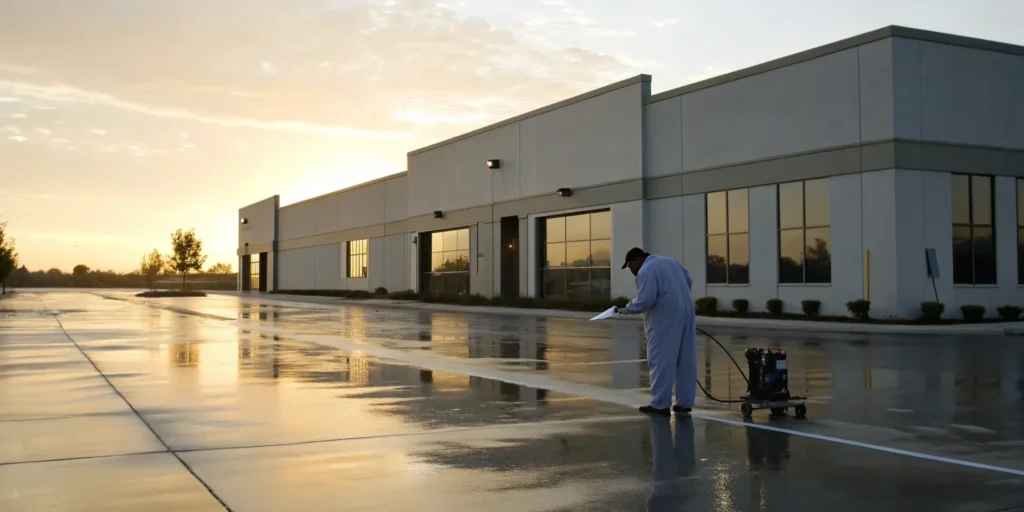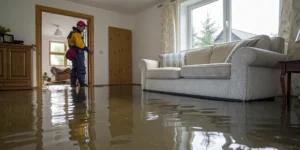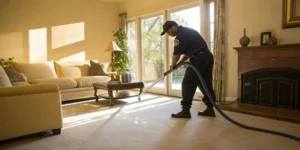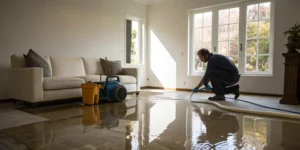Knowing What To Do After A Hurricane Damage
The wind has finally stopped howling. The rain has ceased. But as you step outside and survey the storm damage to your home—the missing shingles, the fallen trees, the water stains creeping across your ceiling—a different kind of worry begins. Where do you even start? Who can you trust for damage restoration? In these vulnerable moments, when you’re desperate to restore safety and normalcy for your family, the last thing you need is to fall victim to someone who would take advantage of your situation.
I understand that weight you’re carrying. Hurricane damage repairs aren’t just about fixing broken boards and patched roofs—it’s about restoring the sanctuary where your family gathers, where memories are made, where you’ve built your life. Whether you’re dealing with water damage, structural issues, or emergency repairs, it deserves to be done right.
As you begin the journey of storm damage restoration, you need more than just a hammer and nails—you need knowledge, discernment, and the confidence to identify who’s truly there to help versus those who see your crisis as an opportunity.
That’s exactly what this guide is for. Together, we’ll walk through the five critical warning signs of hurricane repair scams, and then I’ll show you the proven steps to find an honest, reliable contractor who will be a true partner in rebuilding your home on solid ground.
Guarding Your Resources: The 5 Red Flags
In times of vulnerability, it’s vital to be vigilant. Let’s walk through the warning signs that predatory individuals often show when they target homeowners seeking storm damage restoration services.
Red Flag #1: The “Pay It All in Cash Now” Demand
What it looks like: A contractor shows up and insists on a large upfront payment—sometimes 50%, 75%, or even the entire project cost—before any work begins. They’ll often specifically request cash or push you to wire the money immediately, claiming they need to “secure materials” or “lock in your spot on the schedule.”
Why it’s a warning: Legitimate restoration contractors understand that trust is earned through work, not demanded upfront. When someone pressures you for large cash payments before you’ve seen any results, they’re creating a situation where they can simply vanish with your money. Once that cash is in their hands, you have virtually no recourse if they never return or do substandard work.
The Wise Alternative: Industry standard for storm damage repair projects is a down payment of 10-30% to cover initial material costs. The remaining payments should be tied to specific project milestones—perhaps 25% when materials are delivered, another 25% at the halfway point, and the final balance only when the work is complete and you’ve inspected it. Always pay by check or credit card so you have a paper trail.
Red Flag #2: Unsolicited Door-to-Door Offers
What it looks like: Within days of the storm, a stranger knocks on your door claiming they “just happened to be working in the neighborhood” and noticed your hurricane damage. They offer you a special deal—but only if you sign today. They might even have official-looking signs on their truck and wear branded shirts, but something feels rushed and pressured.
Why it’s a warning: These are “storm chasers”—contractors who follow hurricanes up and down the coast, looking for quick profits. They’re often from out of state, have no local reputation to protect, and will be long gone before you discover the shoddy workmanship, code violations, or that they took your deposit and never returned. By the time you need warranty work or discover problems with your damage repairs, their phone number is disconnected and they’re chasing the next storm.
The Wise Alternative: Take control of your storm damage restoration process by proactively seeking out local, established contractors yourself. Don’t let urgency override good judgment. Yes, you want repairs done quickly, but a few extra days spent finding the right contractor can save you months of headaches and thousands of dollars. Local contractors have a reputation in the community they need to protect—they’re not disappearing after the job is done.
Red Flag #3: “We’ll Handle Your Insurance Claim”
What it looks like: A contractor offers to negotiate directly with your insurance company, promising to “maximize your claim” or get you more money. They might ask you to sign an “Assignment of Benefits” (AOB) form, which gives them the legal right to deal with your insurer on your behalf. Some will even promise to waive your deductible or “eat the cost” themselves.
Why it’s a warning: This is a major red flag that can lead to insurance fraud—and you could be caught in the middle. When you sign away control of your claim, the contractor can inflate costs, perform unnecessary work, or battle with your insurance company while your storm damage restoration sits in limbo. Promising to cover your deductible is actually illegal in many states because it encourages fraudulent claims. You could face denied coverage, legal issues, or be stuck with a lien on your property.
The Wise Alternative: You should always remain the primary contact with your insurance company throughout the damage restoration process. A reputable contractor’s role is to provide a detailed, honest estimate that you can submit to your insurer. They can meet with the adjuster to discuss the scope of work, but they should never push you to hand over control of your claim. Your insurance policy is a contract between you and your insurer—protect that relationship.
Red Flag #4: Lack of Proper Credentials
What it looks like: When you ask about licensing and insurance, the contractor becomes evasive or defensive. They might say “we’re licensed in our home state” or “insurance isn’t necessary for this type of work.” They provide a P.O. box instead of a physical business address, or they can’t produce proof of liability insurance and workers’ compensation coverage when you request it.
Why it’s a warning: Without proper credentials, you’re assuming enormous financial risk. If an unlicensed worker is injured on your property during storm damage repairs, guess who could be liable for their medical bills? You. If they damage your neighbor’s property or cause additional harm to your home, you have no insurance to fall back on. Plus, many local building codes require licensed contractors—using an unlicensed contractor could mean failed inspections and even affect your ability to sell your home later.
The Wise Alternative: Always ask for and verify three things before hiring anyone for damage restoration services:
- A valid contractor’s license (check your state’s contractor licensing board website to verify it’s current and in good standing)
- Proof of general liability insurance (call the insurance company to confirm the policy is active)
- Workers’ compensation insurance (this protects you if someone is hurt while working on your property)
Don’t feel awkward asking for these documents—legitimate contractors expect it and will provide them readily. Whether you’re hiring for residential home repairs or commercial property restoration, proper credentials are non-negotiable.
Red Flag #5: A Vague or Non-Existent Contract
What it looks like: The contractor says “we don’t need all that paperwork—let’s just shake on it” or provides a one-page “agreement” that’s missing crucial details. The document might have vague language like “roof repair” without specifying what materials will be used, what exactly will be repaired, or when the work will be completed.
Why it’s a warning: A verbal agreement or vague contract is the number one source of disputes in storm damage restoration projects. Without specific details in writing, you have no proof of what was actually agreed upon. When conflicts arise about the scope of work, timeline, or costs, it becomes your word against theirs—and you’ll almost always lose that battle, along with your money.
The Wise Alternative: Insist on a detailed, written contract before any restoration work begins. A solid contract should include:
- Detailed scope of work: Not just “fix hurricane damage” but specific tasks like “replace 47 architectural shingles on south-facing roof slope, repair 8 feet of damaged fascia board, seal and paint”
- Complete material list: Including specific brands, quantities, colors, and grades (e.g., “30-year architectural shingles, Owens Corning Duration series, Estate Gray”)
- Total project cost: Broken down by labor and materials
- Payment schedule: Tied to milestones, not dates
- Timeline: Estimated start date and completion date (with allowances for weather delays)
- Warranty information: For both materials and workmanship
- Permit information: Who’s responsible for pulling necessary permits
- Cleanup provisions: Who handles debris removal and final site cleanup
Read every word before signing, and don’t hesitate to ask questions or request changes.
Building on a Solid Foundation: How to Find a Trusted Contractor
Now that you know what to avoid, let’s focus on the positive steps you can take to find a true partner in your storm damage restoration journey—someone who will treat your home or commercial property with the care and integrity it deserves.
Step 1: Seek Local Recommendations
Start by asking people you trust who have their roots in your community. Talk to neighbors who’ve had similar storm damage repair work done. Ask friends and family members—they often know the reliable local contractors who’ve served the community faithfully for years. Visit your local hardware store and ask the staff who they recommend; they see firsthand who buys quality materials and who’s cutting corners. These personal recommendations are invaluable because they come from people who have nothing to gain by steering you wrong.
Step 2: Get Multiple Written Bids
Even if your neighbor gave you a glowing recommendation, always get at least three detailed, written estimates for your damage restoration project. This isn’t about playing contractors against each other or just choosing the cheapest option—it’s about understanding what the job truly entails and what fair market pricing looks like. When you compare the bids side by side, you’ll often discover that one contractor noticed water damage another missed, or that one is including higher quality materials. This process educates you and helps you make an informed decision.
Step 3: Check References and Reviews
Don’t just accept a list of references—actually pick up the phone and call them. Ask specific questions: “Did they show up on time? Did they clean up at the end of each day? How did they handle unexpected issues? Would you hire them again?” Check their standing with the Better Business Bureau and look at reviews on Google, Yelp, and local community Facebook groups. Pay attention to how the contractor responds to negative reviews—do they take responsibility and offer solutions, or do they make excuses and blame the customer?
Step 4: Verify Their Experience with Storm-Related Services
When selecting a contractor for your home or property, ask specifically about their experience with storm damage restoration. Do they offer emergency services for urgent situations? Have they worked with water mitigation after flooding? Can they handle both the immediate damage repairs and the longer-term construction needs? A contractor with comprehensive restoration experience will be better equipped to identify hidden damage and prevent future problems.
Step 5: Insist on a Detailed Written Contract
I know we covered this in the red flags section, but it’s worth repeating: never begin storm damage repair work without a comprehensive, written contract. This protects both you and the contractor. Have someone you trust review it if you’re not comfortable with contracts. It’s perfectly acceptable to say, “I’d like my [attorney/friend/family member] to look this over before I sign.” A trustworthy contractor will respect that caution.
Step 6: Trust Your Intuition
Here’s something that goes beyond checklists and credentials: pay attention to your instincts. If something feels off about a contractor—if they’re evasive, if they pressure you, if you feel uncomfortable—it’s okay to walk away, even if they check all the boxes on paper. Your gut feeling is often picking up on subtle warning signs that your conscious mind hasn’t fully processed yet. Don’t ignore those signals.
Frequently Asked Questions About Home Damage Repair After A Hurricane
Q: How much is a reasonable down payment for storm damage restoration work?
A: Industry standard is 10-30% down, with the bulk of payment coming at project milestones or completion. Be extremely wary of anyone demanding 50% or more upfront. The down payment should cover initial material costs, not fund the contractor’s other projects or lifestyle.
Q: How can I verify a contractor’s license and insurance?
A: Visit your state’s contractor licensing board website—most have an online lookup tool where you can verify a license number and check for complaints or disciplinary actions. For insurance verification, ask for the contractor’s certificate of insurance and then call the insurance company directly (using a number you look up independently, not one the contractor provides) to confirm the policy is active and covers the dates of your project.
Q: What should I do if I think I’ve already been scammed?
A: Act quickly. First, document everything—take photos, save all communications, and gather any paperwork you have. File a report with your local police department and contact your state’s attorney general’s office and consumer protection division. Report the contractor to your state’s licensing board. If you paid by credit card, contact your card company immediately to dispute the charge. Consider consulting with a consumer protection attorney who can advise you on your options for recovering your money.
Q: How long should storm damage repairs take?
A: This varies greatly depending on the extent of damage and the availability of materials and labor after a major storm. Minor repairs might take a few days to a week, while major reconstruction could take several weeks or months. What matters most is that your contractor provides a realistic timeline and keeps you informed of progress. Be suspicious of anyone who promises to complete a major project in an unreasonably short time—they’re likely either overcommitted or planning to do rushed, substandard work.
Q: Should I get permits for damage restoration?
A: In most cases, yes. Significant repairs typically require building permits to ensure the work meets local building codes and is done safely. A reputable contractor will either obtain the necessary permits (and include this cost in their bid) or advise you on which permits you need to pull yourself. Skipping permits can lead to problems when you try to sell your home, issues with your insurance, and safety hazards if the work isn’t inspected. Never let a contractor talk you into skipping the permit process to “save money.”
Q: What’s the difference between water damage mitigation and water damage restoration?
A: Water mitigation refers to the immediate emergency response to stop further damage—extracting standing water, drying out affected areas, and preventing mold growth. This is typically the first step after a storm causes flooding. Water damage restoration is the comprehensive process of repairing and rebuilding what was damaged, which may include replacing drywall, flooring, or structural elements. Quality restoration services should include both mitigation and full repair.
Moving Forward with Confidence
You don’t have to navigate storm recovery alone. SuperClean Restoration Services is your trusted local partner for professional damage assessment, insurance support, and complete restoration—from emergency response to final completion.
The storm may have damaged your house, but it hasn’t destroyed what makes it a home. With knowledge and careful vetting, you’ll find the right professionals for your restoration. By following these guidelines, you’ll protect yourself from scams and ensure quality work that lasts.
What the storm damaged can be restored. What feels overwhelming can be overcome. Contact SuperClean Restoration Services at 844-888-0837 or Info@supercleanrestorationpb.com for expert guidance through every step of your recovery.




